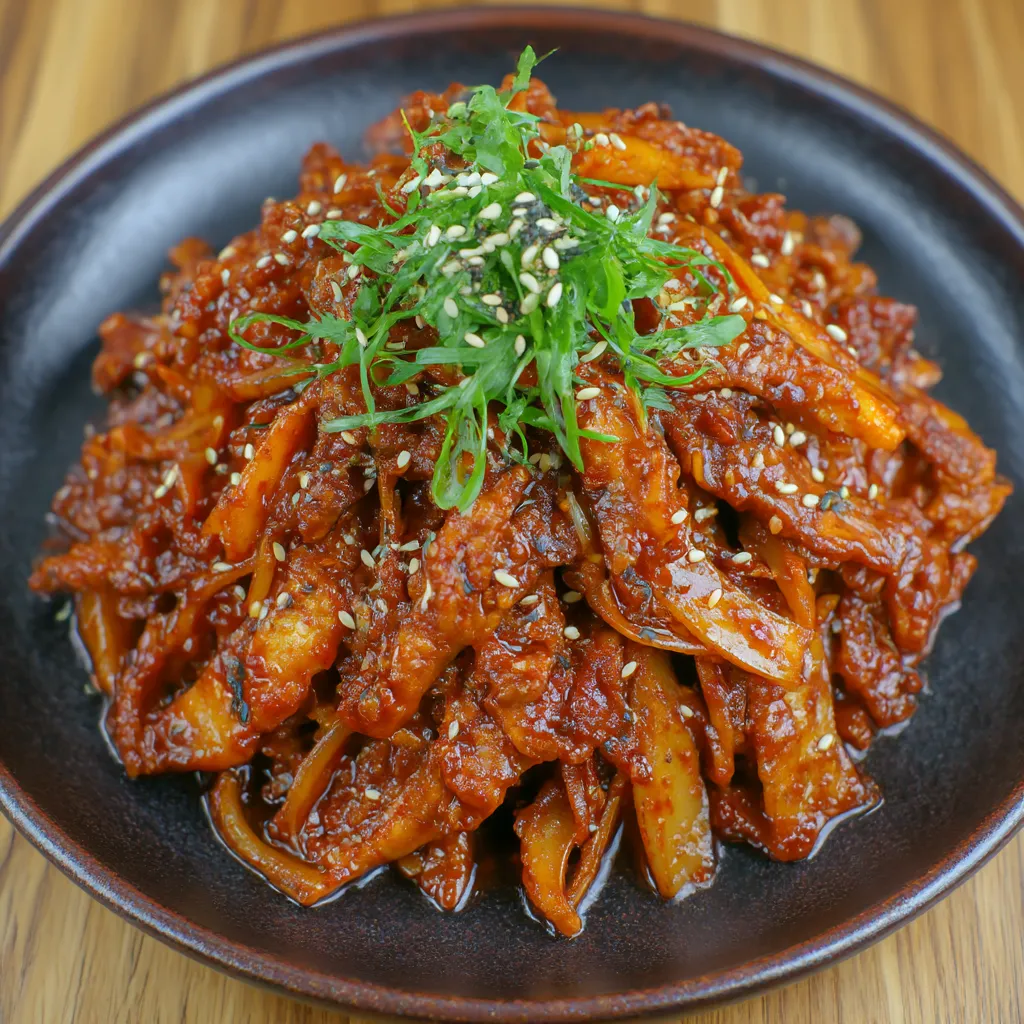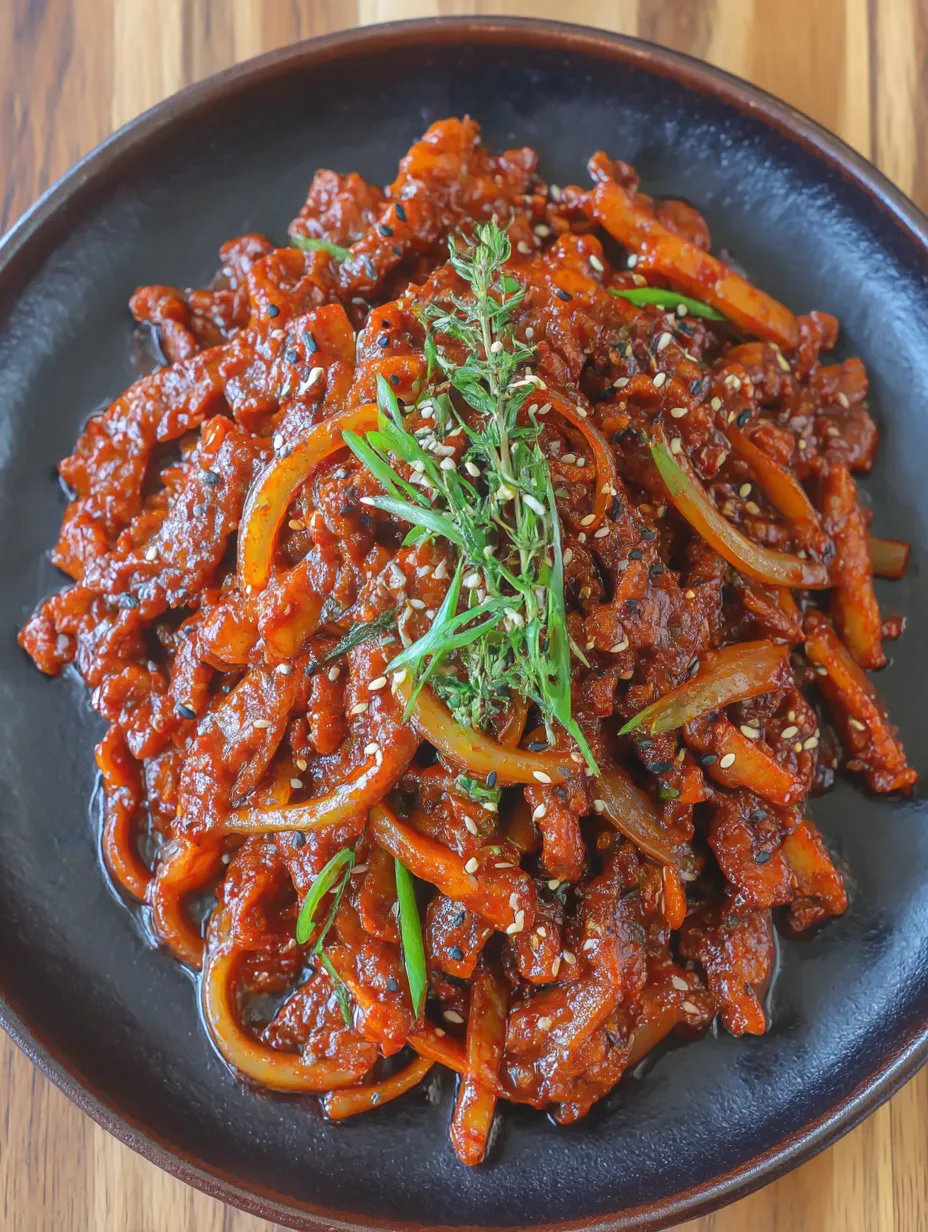 Pin
Pin
Jeyuk Bokkeum or Spicy Pork Bulgogi is that bold Korean dish you crave when you want sweet heat and melt-in-your-mouth savory flavor all at once. This easy recipe is my favorite way to bring those addictive barbecue vibes straight to the dinner table in under half an hour. If you want a punchy stir fry loaded with juicy pork, silky onions, crunchy sesame, and glossy gochujang sauce—this is it.
When I first made this at home I was trying to recreate that street-food magic after a night out in Seoul. It blew my mind how a handful of pantry ingredients transform pork slices into something this bold and comforting.
Ingredients
- Pork belly: thinly sliced brings rich juicy texture and quick cooking Opt for fresh pork with fat marbling and look for even slices at the butcher
- Onion: thinly sliced breaks up richness and turns sweet as it cooks Choose firm onions with shiny skin for best flavor
- Neutral oil: prevents sticking and lets the spicy sauce shine Pick grapeseed or canola oil for clean taste
- Scallion: sliced gives a fresh kick and color Always use crisp bright green parts for topping
- White sesame seeds: add nutty crunch Look for unbroken seeds preferably toasted for aroma
- Gochugaru: Korean red pepper flakes bring smoky heat and signature red color Buy medium spice for balance and check it is vibrantly colored
- Gochujang: Korean fermented chili paste creates deep umami and glossy texture Use traditional brands for best depth of flavor
- Light soy sauce: seasons everything with briny complexity Find naturally brewed soy sauce for full umami
- Mirin: sweet rice wine helps tenderize pork and balances the spice Choose authentic mirin not simply sweetened wine
- Sesame oil: boosts aroma and brings toasty notes Use 100 percent pure toasted sesame oil
- Honey: gives sticky sweetness and helps the sauce caramelize Use mild honey so it does not overpower the gochujang
- Sugar: amps up sweet-spicy impact and helps the pork glaze Choose fine sugar that dissolves fast
- Garlic: minced infuses aromatic pungency Use fresh cloves for real flavor
- Ginger: minced cuts through richness and sharpens flavors Use juicy plump ginger root not dried
- Black pepper: adds a hint of heat and depth Always use freshly ground for complexity
- Apple: grated gives natural sweetness and moistness to the pork Pick a crisp apple like Fuji or Gala
- Water: helps thin and blend the sauce so the marinade clings evenly Use filtered water for cleanest taste
Step-by-Step Instructions
- Mix the Marinade:
- Combine gochugaru gochujang soy sauce mirin sesame oil honey sugar garlic ginger water apple and black pepper in a large bowl Stir thoroughly until the paste and sugar dissolve This is your flavor foundation and blending it well means every piece of meat will be perfectly coated
- Marinate the Pork:
- Add the sliced pork belly and onions to the bowl with the marinade Toss thoroughly to ensure each slice is glossy and evenly colored Let the mixture rest for at least two hours or overnight in the fridge Longer marinading draws the flavors deeper into every bite making the pork even more tender
- Heat the Pan:
- Pour a thin layer of neutral oil into a large wok or heavy skillet Heat over medium until the oil just shimmers Heating the pan thoroughly means the pork will sear not steam
- Stir Fry the Pork:
- Add the marinated pork and onions to the hot wok in a single even layer Avoid crowding the pan or you risk steaming Cook for five to six minutes turning occasionally until the pork is golden at the edges and cooked through If your pan is small work in batches to keep everything sizzling
- Finish and Garnish:
- Once the pork is cooked through remove from heat Sprinkle with scallion slices and a generous shower of white sesame seeds Toss gently and serve right away for best texture and flavor
 Pin
Pin
This dish makes me think of family tables and celebratory gatherings where everyone crowds around sharing laughter and spicy bites The gochugaru is my favorite ingredient for its gentle burn and red color—in my house it was the sign the meal would be special
Storage Tips
This pork keeps well in a sealed container in the fridge for up to three days The flavors deepen as it sits making leftovers even tastier For longer storage freeze portions in airtight bags for up to a month Just thaw overnight in the fridge and reheat in a hot pan to bring back that fresh-cooked sizzle
Ingredient Substitutions
No pork belly Swap in pork shoulder sliced thin for slightly leaner results If you do not have gochujang use a mix of miso and chili paste for similar umami and spice For the apple try a ripe Asian pear or even a splash of apple juice in a pinch
Serving Suggestions
Serve Jeyuk Bokkeum with fluffy steamed rice and generous lettuce leaves to wrap each bite Add kimchi and pickled radish for classic Korean balance A sprinkle of extra sesame and a few fresh chili slices on top give added vibrance
Cultural Context
Jeyuk Bokkeum is a staple of Korean barbecue culture cherished for its quick cooking and bold communal flavor Every region has its twist on the marinade and every family guards their sweet-spicy ratio This is the kind of dish that brings people together around a table filled with side dishes and warm conversation
Recipe FAQs
- → Comment rendre le plat moins épicé ?
Diminuez la quantité de gochugaru ou optez pour un gochujang plus doux. Ajoutez un peu de sucre et servez avec du riz pour équilibrer.
- → Peut-on utiliser un autre morceau de porc ?
Oui, l'échine de porc coupée finement fonctionne également très bien, tout comme le filet, pour une version plus maigre.
- → Combien de temps faut-il mariner la viande ?
Au moins 2 heures, mais une nuit au réfrigérateur permet aux saveurs de mieux pénétrer la viande.
- → Peut-on préparer ce plat à l'avance ?
Oui, il se réchauffe facilement. Conservez la viande marinée au frais et faites-la sauter juste avant de servir pour plus de fraîcheur.
- → Quels accompagnements suggérez-vous ?
Servez avec du riz blanc, des feuilles de laitue ou des légumes sautés pour un repas complet et équilibré.
- → Comment éviter que la viande ne rende trop d'eau ?
Saisissez la viande en plusieurs fois dans un wok bien chaud pour favoriser une cuisson rapide et croustillante.
